Nebraska’s capital will play host to an FMCA convention in August — the first in the state — and it offers much for RVers to explore before and after the event.
By Dorothy Rieke
June 2022
Some years ago, Lincoln, Nebraska, was given the nickname “Star City” – a nod to the fact that a star pinpoints the state capital on maps. However, Lincoln residents today may cite other reasons their home merits this designation. Like the five points of a star, Lincoln shimmers with excitement when the University of Nebraska “Big Red” teams perform; it glitters with all that is bright, providing golden opportunities; it glimmers with its historical past; and it shines with its friendliness and goodwill toward others. Oh, yes, Lincoln is a “Star City” in all respects.
In the Nebraska territory’s early days, two things attracted settlers to the Lincoln area. Some followed the dream of owning land, thanks to the Homestead Act signed by the U.S. Congress in 1862, which offered acreage to those willing to settle there for at least five years. Others were attracted by an extensive, far-reaching underground salt basin and dreamed of making a fortune selling salt — necessary at the time for preserving meat. This convinced some that they could live like kings in a great city built on salt rewards.
Civil engineer Augustus F. Harvey wrote, “There is no question of the vast wealth which will someday be derived from this region.” That never came to pass, however. Difficulties arose related to mining and shipping the salt, along with legal problems with leases of salt lands from the state. In addition, J. Sterling Morton had already foreseen this opportunity when he learned of salt deposits in Kansas. His salt and its distribution already were widespread during early settlement days.
Down through the years, even with increases in population, Lincoln has retained much of the pioneer spirit. Immigrants from other lands left all they knew in hopes of building a better life in the American West, including Lincoln. The work involved in settling in Nebraska and building a place to live required individuals with many desirable traits, among them courage, perseverance, industry, and an attitude of forward thinking.
At that time in history, the territorial capital was Omaha, Nebraska, and people living in that city meant to keep it there. However, those living south of the Platte River and farther west wanted a capital closer to their locations. The first territorial governor died soon after arriving in Nebraska and was replaced by Thomas B. Cuming, who declared that Omaha should be Nebraska’s capital city, which enraged those determined “to strip that city of its prize.”
Lawmakers in favor of the Omaha location filibustered, participating in violent actions, including exchanging death threats. Fists and guns were brandished. Finally, after 13 years of fierce struggle, it was decided that this territory, now a state, would have its seat in a tiny town with 30 residents south of the Platte River, a place called Lancaster. Some considered the town’s name to be “inexplicably clumsy and ugly.” Later, the decision was made to rename Lancaster in honor of Abraham Lincoln, the deceased 16th president of the United States. Of course, some former slave owners “disliked the name of Lincoln more than Satan himself.” In spite of these sentiments, the city ended up being named Lincoln. The state capitol there was completed in 1868.
Many important events have taken place in Lincoln since its founding. In 1869, the University of Nebraska–Lincoln was opened by an act of the Nebraska state legislature, which stated: “The object of such an institution shall be to afford to the inhabitants of the state the means of acquiring a thorough knowledge of the various branches of literature, science, and the arts.”
The early football teams, playing under names such as the “Bug Eaters,” “Gold Knights,” “Antelopes,” and “Rattlesnake Boys,” ultimately became the “Cornhuskers.” The University of Nebraska football team now claims 46 conference championships and five national championships.
Today, Lincoln has evolved into a large city with a hometown feel. In fact, in 2013, it was named one of the “Top Ten Most Welcoming Cities in America” by Welcoming America, a grassroots organization that encourages inclusion. Lincoln offers the advantages of a safe environment, with many attractions that inform and delight visitors. O Street, one of the world’s longest main streets, stretches east and west for 59 miles. This “backbone” of the city features many shops, hotels, restaurants, and the Gateway Mall.
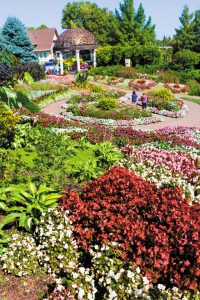
More than 30,000 annuals fill Sunken Gardens’ floral displays, and the design changes each year.
An Oasis Of Natural Beauty
If you are searching for a place of quiet contemplation in an enchanting setting, the Sunken Gardens in Lincoln fits that description. Listed as one of the “300 Best Gardens to Visit in the United States and Canada” by National Geographic, it features thousands of flowering plants, along with walkways, a waterfall, and sculptures.
Sunken Gardens is located in Antelope Park, which also is home to Veterans’ Memorial Garden, Hamann Rose Garden, the Strolling Garden, Ager Golf Course, and a playground. Location: 27th and Capitol Parkway. Admission is free, but donations are accepted. Visitors may park at the Lincoln Children’s Zoo and spend some time there before walking across the street to the gardens.
All That’s Rollin’
The Speedway Motors Museum of American Speed, located at 599 Oakcreek Drive, is a “Smithsonian quality” collection exhibiting everything related to early speed development. Racing cars, touring cars, and engines are displayed along with metal lunchboxes, movie posters, pedal cars, record-album covers, hood ornaments, and vintage car parts. Visitors also can view a carousel, tether cars, pedal airplanes, toys, bronze art, and the car that David Pearson drove to beat Richard Petty in the 1976 Daytona 500. Hot Rod magazine included this museum on its list of “101 Car-Guy Things To Do Before You Die.” But even if you are not an auto enthusiast, your experience at this museum will be memorable. Admission: adults under 60, $15; adults 60 and up, $10; veterans/college students, $10; children 6 to 17, $5; children 5 and under, free. Active military members are admitted free, and military families may receive discounts. Phone: (402) 323-3166.
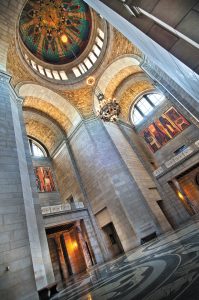
The state capitol boasts murals, mosaics, stained glass, and other artful touches.
Stepping Out With The Lawmakers
The Nebraska State Capitol, often called “Tower on the Plains,” is stunning. It successfully incorporates a functional tower into its design. Described as a “living, breathing work of art celebrating the human and natural history of the state,” it serves as the centerpiece of the United States’ only unicameral (one house) legislature. The limestone and marble hallways are adorned with amazing mosaics and paintings. Location: 1445 K St. Admission is free. Guided tours begin at the north entrance second floor Monday through Friday on the hour (except at noon) between 9:00 a.m. and 4:00 p.m.; Saturday, 10:00 a.m. to 4:00 p.m.; Sunday 1:00 p.m. to 4:00 p.m. Call (402) 471-2311 for more information.
The Governor’s Residence
The Nebraska Governor’s Residence is on the National Register of Historic Places and is within walking distance of the capitol. Renovated in 1997, the modified Georgian Colonial home has 27 rooms, including five bedrooms, 12 bathrooms, four fireplaces, and a three-stall garage. Location: 1425 H St. Public tours are available only on Thursday afternoons by appointment; phone (402) 471-3466. Appointments must be made at least two weeks in advance and are not available from mid-December through March.
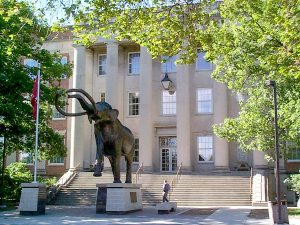
A bronze likeness of “Archie,” the famed Columbian mammoth, stands outside Morrill Hall at the University of Nebraska.
All That Remains Of Past Life
Part of the University of Nebraska State Museum, Morrill Hall, or “Elephant Hall,” is considered one of the best museums of natural history in the Midwest. Housed in a massive four-story building on the University of Nebraska–Lincoln campus, it is filled with evidence of Nebraska’s past and present biological diversity, its cultural heritage, and many fossils. Archie, the world’s largest mounted Colombian mammoth fossil, is on display. A planetarium allows visitors to explore our universe. Note that it is not possible to see everything in one visit. Location: 645 N. 14th St. Admission: adults, $9.50; adults 65 and older, veterans, and active military members, $8.50; children ages 3 to 18, $5.50; under 3, free. Open Tuesday through Saturday from 9:00 a.m. to 5:00 p.m. and Sunday from noon to 5:00 p.m. Phone: (402) 472-2637.
Calling All Quilt Lovers
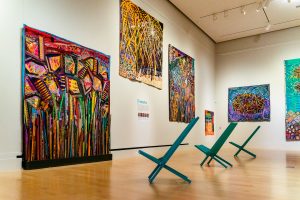
The International Quilt Museum celebrates quilting culture and artistry.
The International Quilt Museum is home to the world’s largest publicly held quilt collection. Interesting and educational exhibits represent quilts and quilt-making traditions from around the world down through history, with much to appreciate, such as design, stitching, and materials. This museum offers a one-of-a-kind experience, bringing both elegance and beauty to visitors. Displays include more than 6,000 pieces representing 50 countries. Location: 1523 N. 33rd St. Admission: adults, $8; seniors, $6; children 5 to 18, $4; under 5 years, free. Phone: (402) 472-6549.
Shopping Pleasures
If you are searching for great restaurants, unique shopping experiences, antiques stores, and art galleries, the Historic Haymarket District has it all. The name Haymarket stems from the original market square of 1867, where wagons, camping equipment, and hay were bought and sold. Iron Horse Park, located on the north side of this area, features a restored CB&Q steam engine and an 1890s water tower fountain. Also located here is the Lincoln Historical Ghost Quest, which provides walking ghost tours. This area is home to Pinnacle Bank Arena, a sports and entertainment venue. Location: Eighth and P streets.
SouthPointe Pavilions, an open-air shopping center/mall, excels in entertainment, shopping expeditions, and dining. Location: 2910 Pine Lake Road.
Often overlooked is the historical architecture in Lincoln’s downtown area. Easily covered on foot, this area gives a glimpse of the city’s history with fascinating attractions for those who take time to explore. Location: O Street.
Gateway Mall, located at 6100 O St., is known for its food court and its many retail stores. A colorful carousel and several candy and cookie booths attract children especially.
Today, beautiful, historic Lincoln is a vibrant and safe city of nearly 300,000 welcoming, warmhearted people. It offers many of the cultural, entertainment, and employment benefits of a much larger city but with the atmosphere of a friendly Midwestern community. It is an ideal place to spend some time relaxing and enjoying a very special experience.
More Museums
Nebraska History Museum relates stories of the people and cultures who have made this area their home. It contains many artifacts and stories of a rich past dating back 12,000 years. Location: 131 Centennial Mall N. Open Tuesday, Wednesday, Friday, and Saturday from 9:00 a.m. to 4:00 p.m.; Thursday, 9:00 a.m. to 8:00 p.m. Admission: adults, $5; children 5 to 18, $3; under 5, free. Phone: (402) 471-4782.
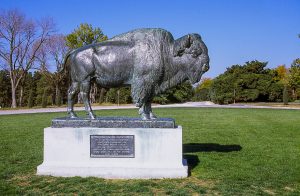
This life-sized bronze bison, one of Lincoln’s best-known sculptures, presides over Pioneers Park.
Pioneers Park Nature Center, within Lincoln’s Pioneers Park, contains 668 acres of tall grass prairie, woodlands, wetlands, and a stream. Eight miles of hiking trails wind through various habitats and exhibits, some including bison, elk, and white-tailed deer. This center offers an opportunity to walk through the prairie, meet the exhibit animals, hear the birds’ songs in the bird garden, and enjoy the unique atmosphere of herb gardens. Location: 3201 S. Coddington Ave. Open Monday through Saturday, 9:00 a.m. to 4:30 p.m.; Sunday, noon to 4:30 p.m.; closed on holidays. Admission is free but donations are accepted. Phone: (402) 441-7895.
Sheldon Museum of Art, on the University of Nebraska–Lincoln campus, was founded in 1888. It now contains nearly 13,000 works of art, including prominent holdings of 19th-century landscape and still life, American impressionism, early modernism, geometric abstraction, abstract expressionism, pop, minimalism, and contemporary art. In addition, more than 30 sculptures are located throughout the university’s City and East campuses; these include major works by Jacques Lipchitz, Claes Oldenburg, Coosje van Bruggen, Richard Serra, and Mark di Suvero. The museum is open to the public Tuesday through Saturday from 10:00 a.m. to 4:00 p.m. (closed on holidays and days of home football games). Location: 12th and R streets. Admission: free. Phone: (402) 472-2461.
Great Plains Art Museum, located downtown on the University Of Nebraska–Lincoln campus, exhibits art that interprets the history, culture, environment, and creative spirit of North America’s Great Plains. It showcases art of the American West, along with American Indian art. The collection encompasses bronze sculptures, paintings, drawings, and photographs. Artists include Albert Bierstadt, William de la Montagne Cary, William Henry Jackson, Frederic Remington, Charles M. Russell, Keith Jacobshagen, and Juane Quick-to-See Smith. Location: 1155 Q St. Open Tuesday through Saturday from 10:00 a.m. to 5:00 p.m.; closed on holidays and between exhibitions. Admission: free. Phone: (402) 472-6220.
The Lester F. Larsen Tractor Test and Power Museum is located on the East Campus of the University of Nebraska–Lincoln. If you like tractors and especially enjoy viewing vintage tractors, this is the place for you. Every model of every tractor sold in Nebraska is tested here for performance. Years ago, a farmer purchased a tractor that was a “lemon.” Later, as a Nebraska legislator, he sponsored a bill that required testing of all tractors sold in Nebraska. An informative guide leads visitors through the facilities. Location: 35th Fair St. Open Tuesday through Friday from 9:00 a.m. to 4:00 p.m. Admission is by donation; suggested amount, $5 (except for University of Nebraska–Lincoln students and staff, military families, and veterans). Group tours may be scheduled. RV parking is available near the Nebraska Tractor Testing Lab northwest of the museum. Phone: (402) 472-8389.
More Info
Lincoln Convention And Visitors Bureau
www.lincoln.org
(800) 423-8212
University of Nebraska–Lincoln
www.unl.edu
(402) 472-7211
Visit Nebraska
www.visitnebraska.com/lincoln
(402) 471-3796

